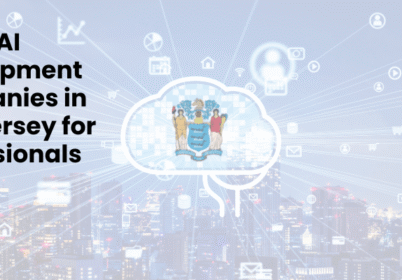How to Use Midjourney: A Beginner’s Guide to Stunning AI Art
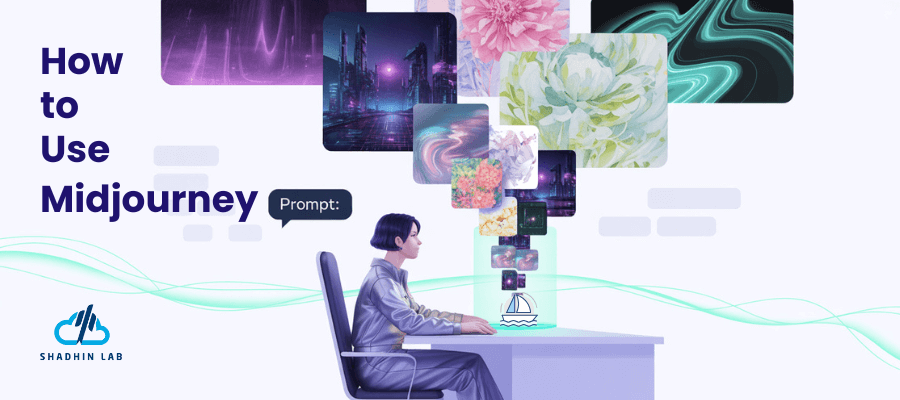
Table of Contents
Midjourney has emerged as a leading generative AI tool for creating stunning images with remarkable precision and artistic flair. This innovative platform transforms text descriptions into visual masterpieces through sophisticated artificial intelligence technology. How to use Midjourney has become a popular search query as creative professionals discover its immense potential for digital art creation. The platform stands out for its distinctive artistic style and impressive ability to interpret complex prompts with nuanced understanding. How to use Midjourney effectively requires understanding its unique interface and mastering prompt structures that yield optimal results. This comprehensive guide explores Midjourney fundamentals, including setup procedures, practical applications, pricing details, and advanced prompt techniques. We will walk through each step of the process to help you create captivating AI-generated artwork for various professional and personal projects.
Table of Contents
What Is Midjourney and How Does It Work?
Midjourney is an AI-powered image generation tool that transforms text prompts into visual artwork through sophisticated deep learning algorithms. Unlike traditional design software requiring manual creation, Midjourney builds images from scratch based solely on textual descriptions provided by users. The platform operates primarily through Discord, a messaging and community platform where users input commands to generate images. Midjourney processes these text prompts through its neural network trained on millions of diverse images and artistic styles from across art history.
What distinguishes Midjourney from competitors like DALL-E and Stable Diffusion is its distinctive artistic signature and aesthetic quality. The platform excels at creating painterly renditions with dramatic lighting, compelling composition, and artistic coherence across diverse subjects. Images generated by Midjourney feature rich textures, vibrant colors, and artistic flourishes reminiscent of professional illustrations rather than typical AI output. The system processes prompts through specialized high-performance servers and delivers multiple image variations for users to select and refine.
Midjourney’s technology continues to evolve with regular model updates that improve image quality and prompt interpretation capabilities. The current version offers enhanced capabilities for photorealistic imagery, accurate text rendering within images, and complex scene composition with multiple elements. The platform’s accessibility through Discord creates a uniquely collaborative environment where users learn from observing others’ prompts and results. This community-based approach fosters an educational ecosystem where techniques and creative approaches are freely shared among users.
How To Use Midjourney AI: A Step-by-Step Guide
Getting started with Midjourney requires following several specific steps to access and utilize the platform effectively:
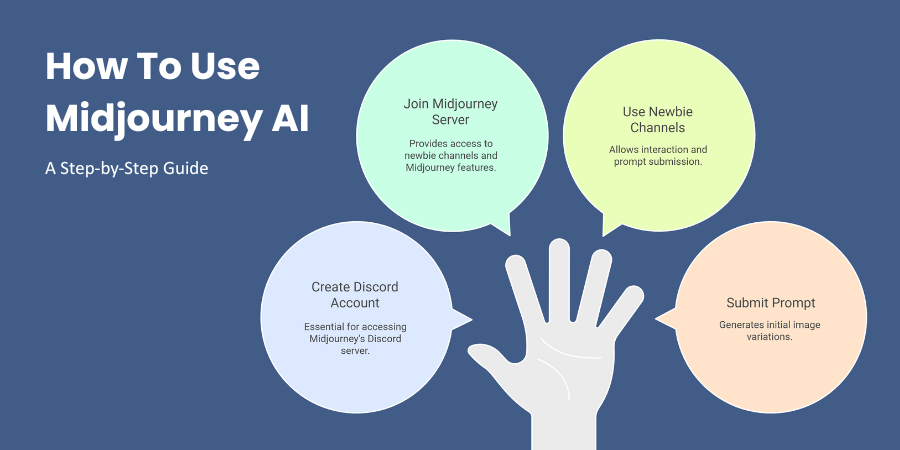
- Create a Discord account if you do not already have one by visiting discord.com and completing the registration process
- Navigate to midjourney.com and click the Join Beta button to access the official Midjourney Discord server
- Locate and join one of the available newbie channels labeled #newbies in the server sidebar
- Type /imagine followed by your text description in the Discord message field.
- Press Enter to submit your prompt and wait approximately 30-60 seconds for Midjourney to generate four initial image variations
After receiving your images, you will see several interactive buttons beneath them offering different options. Click U1, U2, U3, or U4 to upscale any specific variation to a higher resolution with enhanced details. Alternatively, select V1, V2, V3, or V4 to create variations of a particular image that maintain similar elements. The upscaled images provide greater detail and clarity for your selected design.
For more control over your creations, incorporate parameters into your prompts using double dashes before each parameter. For instance, type “/imagine mountain landscape —ar 16:9” to specify a widescreen aspect ratio for your image. Other useful parameters include —stylize to adjust artistic intensity and —quality to determine rendering time and detail level. Experiment with —chaos followed by a number between 0-100 to increase randomness and creativity in your results.
To save your generated images, simply right-click on any image and select “Save image as” from the context menu. For organization purposes, consider creating dedicated folders on your device for different Midjourney projects or artistic styles. Remember that free trial users have limited generations, while subscribers receive a monthly allocation based on their subscription tier.
Mastering Midjourney requires practice and experimentation with different prompt structures and parameters. Begin with simple descriptions and gradually incorporate more specific details about style, lighting, and composition. Join the official Midjourney documentation site for comprehensive guides and parameter references that will enhance your technical understanding.
Best Use Cases of Midjourney
Midjourney isn’t just about creating pretty pictures—it’s a powerful tool that’s transforming creative workflows across industries. Below are some of the most practical and impactful ways Midjourney is being used today.
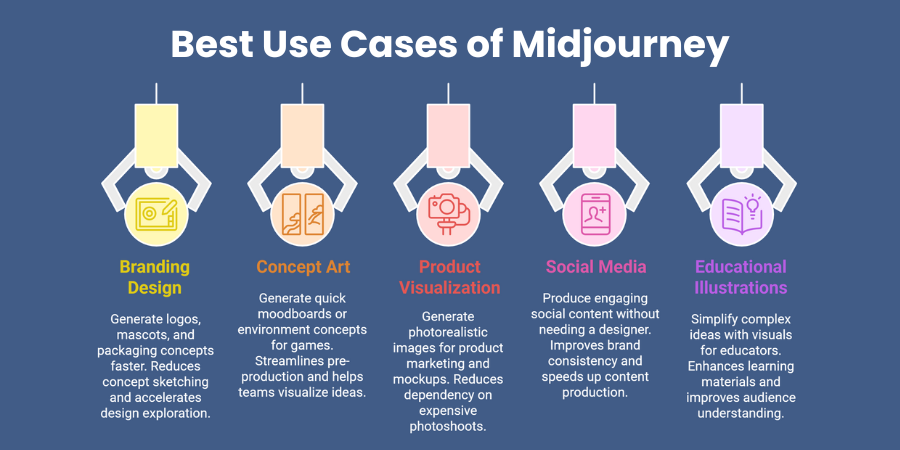
1. Branding and Visual Identity Design
Brands use Midjourney to generate unique logos, mascots, packaging concepts, and visual identity assets faster than ever.
How it Works:
Designers enter prompt instructions combining brand themes, aesthetics, and tone (e.g., “minimalist tech logo with blue gradients”) to explore ideas.
Impact:
It reduces hours of concept sketching and accelerates design exploration while sparking new creative directions.
Example: A startup used Midjourney to visualize three distinct brand styles before hiring a designer—cutting concept time in half.
2. Concept Art for Games and Films
Midjourney is a game-changer for concept artists working in film, animation, or video games.
How it Works:
By entering imaginative scene prompts (e.g., “cyberpunk city skyline at sunset”), artists can generate quick moodboards or environment concepts.
Impact:
It streamlines the pre-production phase and helps teams visualize ideas before investing in full 3D assets.
Example: An indie game developer used Midjourney to develop atmospheric level design ideas for a sci-fi platformer.
3. E-commerce and Product Visualization
Online retailers use Midjourney to generate photorealistic images for product marketing, packaging, or mockups.
How it Works:
Sellers input prompts like “luxury skincare bottle on marble with soft lighting” to create polished visuals for websites or social ads.
Impact:
It reduces dependency on expensive photoshoots, especially for MVPs or pre-launch phases.
Example: A DTC beauty brand created 12 product mockups in a day using Midjourney instead of staging a full shoot.
4. Social Media Content Creation
Midjourney helps marketers produce engaging and visually arresting social content without needing a designer for every post.
How it Works:
By describing themed visual prompts (e.g., “vintage coffee shop in watercolor style”), brands can align content with trends and holidays.
Impact:
It improves brand consistency, boosts engagement, and speeds up content production cycles.
Example: An Instagram travel blogger used Midjourney to create fantasy-style cityscapes that went viral on Pinterest.
5. Educational Illustrations and Infographics
Teachers, educators, and content creators use Midjourney to simplify complex ideas with visuals.
How it Works:
Prompts like “digestive system in 3D render with labels” or “AI workflow diagram in minimal flat style” help generate customized illustrations.
Impact:
It enhances learning materials and improves audience understanding, especially for visual learners.
Example: An online educator used Midjourney-generated infographics in her tech bootcamp, improving student comprehension and course reviews.
Crafting Effective Midjourney Prompts
Creating powerful Midjourney prompts requires understanding fundamental structure principles that maximize AI comprehension and artistic output. The most effective prompts follow a consistent pattern: subject + style + modifiers + aspect ratio. Begin with a clear description of your main subject, whether a person, landscape, object, or abstract concept.
Follow this with specific style references such as “oil painting,” “photorealistic,” or “anime style” for artistic direction. Add modifiers for lighting, mood, color palette, and composition details that enhance the scene. Finally, specify technical parameters like aspect ratio for precise dimensional control.
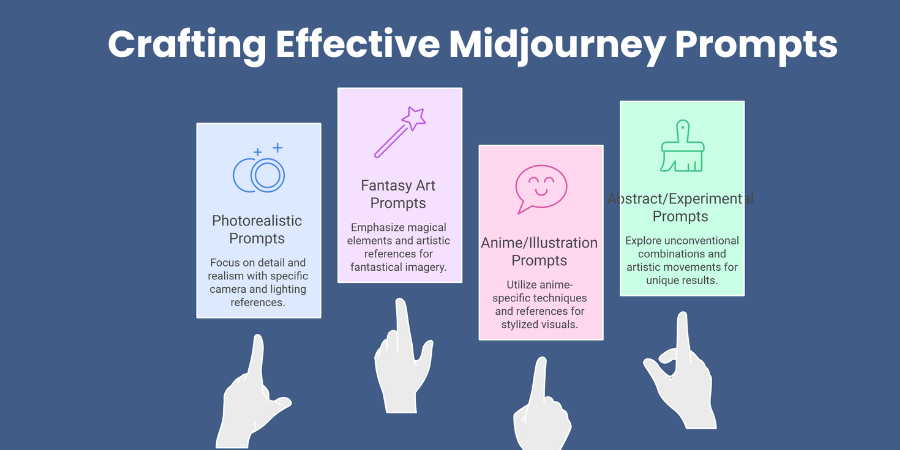
Photorealistic prompts demand specific attention to detail and reference points for optimal results, including:
• Camera specifications like “shot on Canon 5D” or “85mm lens” to guide the rendering style
• Lighting conditions such as “golden hour lighting” or “studio lighting with soft boxes”
• Professional photographer references or specific photography styles for stylistic guidance
• Details about environment, weather conditions, and subject positioning for convincing realistic imagery
Fantasy art prompts benefit from rich descriptive language and specific artistic references for magical elements. Mention fantasy artists like “in the style of Frank Frazetta” or “inspired by Magic: The Gathering artwork.” Describe magical elements, creatures, and environments with specific color palettes and atmospheric conditions. Include terms like “epic scale,” “dramatic lighting,” or “mystical atmosphere” to enhance the fantastical quality. Specify materials like “ancient stone,” “gleaming armor,” or “ethereal mist” for texture and depth.
Anime and illustration style prompts require different terminology and reference points for accurate stylization. Reference specific anime studios like “Studio Ghibli style” or “similar to Makoto Shinkai” for recognizable aesthetics. Mention art techniques such as “cel shading,” “line art,” or “vibrant flat colors” for appropriate rendering. Include character emotion descriptors and action poses for dynamic compositions that capture movement. Specify background complexity and focus effects like “detailed cityscape background” or “bokeh effect.”
Abstract and experimental prompts allow for creative exploration beyond conventional imagery and representational art. Combine unexpected elements like “fractal patterns merging with organic forms” for unique visual combinations. Use emotional and sensory descriptors such as “representation of anxiety” or “visual interpretation of jazz music.” Incorporate artistic movements like “cubist interpretation” or “surrealist composition” for stylistic guidance. Experiment with unusual parameter combinations and high chaos values to generate unexpected results.
How Much Does Midjourney AI Cost?
Midjourney offers several subscription tiers designed to accommodate different usage needs and budgets for various creator types:
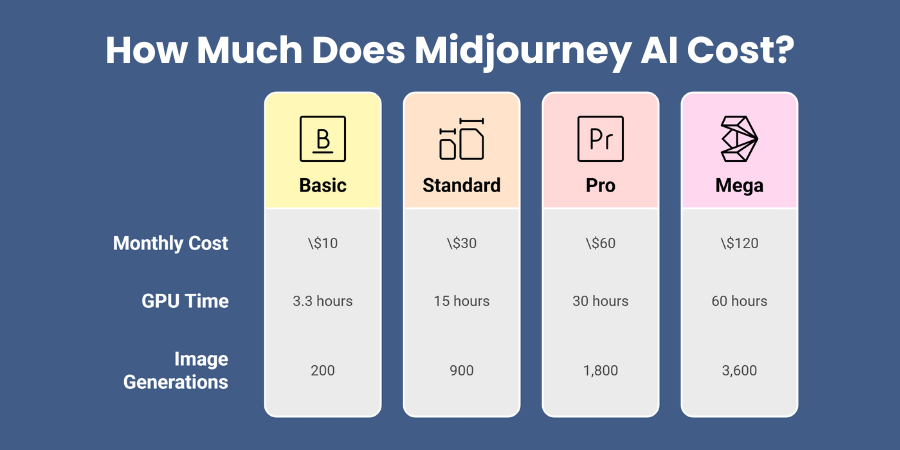
- Basic Plan: $10 per month providing approximately 3.3 hours of GPU time (roughly 200 image generations)
- Standard Plan: $30 monthly delivering approximately 15 hours of GPU time (roughly 900 image generations)
- Pro Plan: $60 per month providing approximately 30 hours of GPU time (around 1,800 image generations)
- Mega Plan: $120 monthly delivering approximately 60 hours of GPU time (roughly 3,600 image generations)
All paid plans include commercial usage rights, though specific terms vary by subscription level and usage context. Free trial users receive a limited number of generations to explore the platform before committing to a subscription plan. Midjourney occasionally updates pricing and plan features to reflect new capabilities and server costs. Annual payment options offer discounts compared to monthly billing across all subscription tiers for cost-conscious users.
How to Use Midjourney Without Discord
Currently, Midjourney primarily operates through Discord as its main interface for image generation and user interaction. The official Midjourney web platform offers limited functionality compared to the Discord implementation for most users. Users can view their image history, adjust account settings, and manage subscription details through the web interface. However, the actual image generation process still requires Discord for prompt submission and processing.
Some third-party services claim to provide alternative access methods to Midjourney functionality through unofficial integrations. These unofficial integrations should be approached with caution regarding security concerns and terms of service compliance. Many such services violate Midjourney’s terms of use and may compromise account security or image rights. The Midjourney team actively discourages using unofficial access methods that circumvent their established platforms.
Midjourney has announced plans to expand direct web access capabilities in future platform updates. The development roadmap includes more comprehensive web interface features that may eventually reduce Discord dependency. These improvements aim to provide enterprise users with more seamless integration options for professional workflows. However, no specific timeline has been provided for full Discord-independent functionality.
For users seeking alternatives to Discord-based interaction, several workarounds exist within the official ecosystem. The Midjourney Discord bot can be added to private Discord servers for a more controlled environment. This approach maintains all functionality while limiting interaction to specific team members or collaborators. Enterprise customers can contact Midjourney directly to discuss specialized access options for corporate environments.
Discord remains mandatory for Midjourney’s core functionality due to several technical and practical factors. The platform provides robust infrastructure for handling image processing requests and user authentication systems. Discord’s server architecture efficiently manages the high volume of concurrent requests from thousands of users. The community aspect of Discord also facilitates learning and inspiration through observation of other users’ prompts and results.
How to Prompt Midjourney Effectively
Mastering prompt structure fundamentals dramatically improves your Midjourney results across all image types and artistic styles. Begin prompts with the most important elements first, as earlier words receive higher priority in processing. Use colons to separate major concept groups such as “subject: style: setting: lighting” for clearer AI interpretation. Incorporate specific descriptive adjectives rather than vague terms for more precise outcomes. Experiment with prompt length, as both concise and detailed approaches yield different but valuable results.
Specificity in descriptive language transforms generic images into distinctive, personalized creations with unique character. Replace general terms like “beautiful” with specific descriptors like “ethereal,” “vibrant,” or “weathered” for clearer direction. Name exact colors such as “cerulean blue” or “crimson red” rather than basic color terms. Reference specific materials like “brushed aluminum,” “weathered leather,” or “polished marble” for texture clarity. Include precise time periods, cultural references, or artistic movements for stylistic guidance.
Camera angles, perspectives, and technical photography terms provide crucial compositional control, including:
• Viewpoints like “bird’s eye view,” “worm’s eye view,” or “Dutch angle” for interesting perspectives
• Lens information such as “shot with 85mm lens” or “wide-angle lens” to affect distortion and focus
• Specialized techniques like “bokeh background,” “tilt-shift effect,” or “long exposure” for artistic effects
• Distance descriptors like “extreme close-up” or “establishing shot” to control framing and subject emphasis
Lighting and atmosphere specifications dramatically enhance mood and visual impact in generated images. Describe lighting conditions like “golden hour sunlight,” “dramatic backlighting,” or “soft diffused lighting” for mood setting. Specify atmosphere with terms like “foggy,” “hazy,” “crisp,” or “ethereal” to establish environmental context. Include weather conditions such as “after rainfall,” “snowy scene,” or “dusty environment” for added realism. Mention color temperature with terms like “warm amber glow” or “cool blue tones.”
Style modifiers and artist references provide shorthand for complex aesthetic directions that guide the AI. Reference specific artists with phrases like “in the style of Monet” or “inspired by H.R. Giger” for recognizable aesthetics. Mention art movements such as “art deco,” “cyberpunk,” or “impressionist” for stylistic frameworks. Include media types like “watercolor,” “charcoal sketch,” or “digital illustration” for technique simulation. Combine multiple style references with connecting words for hybrid aesthetics like “blending baroque and futuristic elements.”
Testing and iteration remain essential practices for achieving desired results consistently across projects. Save successful prompts in a personal library for future reference and modification when needed. Systematically change one element at a time to understand how each affects the final image. Use the —seed parameter to maintain consistency while testing different prompt variations. Join Midjourney community forums to learn from others’ prompt experiments and share your discoveries.
Conclusion
Midjourney is reshaping the creative landscape by enabling anyone to generate high-quality visuals from simple text prompts. Its unique blend of artistic style and AI precision empowers users across industries to visualize ideas faster and more effectively. The platform excels in concept exploration, allowing designers, marketers, and artists to test creative directions before full execution. It accelerates workflows without the need for extensive graphic resources or technical expertise. For best results, Midjourney should be seen as a collaborative tool, where human creativity guides and refines AI outputs.
Improving prompt engineering skills enhances results and unlocks more creative possibilities over time. As Midjourney evolves, new features and a growing user community continue to enrich the experience. Its accessibility and powerful capabilities make it an essential tool for anyone exploring visual storytelling or design innovation.
Frequently Asked Questions
Can I use Midjourney images commercially?
Yes, Midjourney allows commercial usage of generated images depending on your subscription tier. Basic, Standard, Pro, and Mega plans include commercial rights with varying terms. Free trial users cannot use images commercially under any circumstances. Always review the current terms of service for specific limitations regarding usage rights and attribution requirements.
How many images can I generate with Midjourney?
The number of images depends on your subscription plan. Basic subscribers ($10/month) can create approximately 200 images monthly. Standard subscribers ($30/month) receive about 900 generations. Pro users ($60/month) can generate around 1,800 images. Mega plan subscribers ($120/month) receive approximately 3,600 image generations monthly based on current allocation rates.
Does Midjourney work on mobile devices?
Yes, Midjourney works on mobile devices through the Discord mobile app available for iOS and Android. The experience remains functional though somewhat limited compared to desktop usage. Users can generate images, upscale results, and create variations through mobile interfaces. The Midjourney web platform also offers mobile-responsive design for viewing image history and account management.
How can I improve my Midjourney prompt results?
Improve results by using specific descriptive language instead of vague terms. Structure prompts with subject first, followed by style, setting, and technical parameters. Reference specific artists, art movements, or photographic styles for stylistic guidance. Experiment with parameters like —stylize and —chaos to fine-tune artistic interpretation. Save successful prompts and iterate systematically to understand what produces desired outcomes.
Shaif Azad
Related Post
Top 10 AI Development Companies in New Jersey for Business
Are you searching for the perfect AI development partner in New Jersey? Have you wondered which...
Top 10 AI Development Companies in New Hampshire
Are you watching New Hampshire’s tech landscape transform before your eyes? Your state is quietly becoming...
Top AI Companies in Nebraska Every Business Should Know
Are you a Nebraska business owner wondering how artificial intelligence could transform your operations? Picture this...

